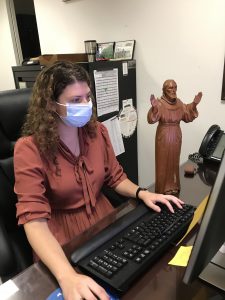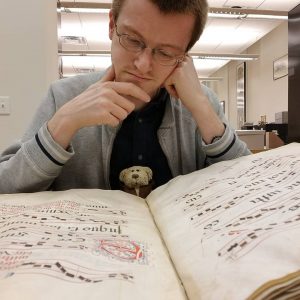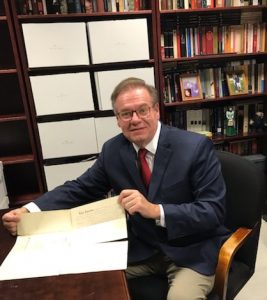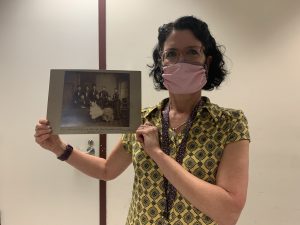Most major institutional libraries have Special Collections, but what exactly are Special Collections and why are they so special? A special collection is a group of items that includes rare books, museum objects, or archival documents. They are irreplaceable or otherwise unique and valuable. Special collections are usually housed separately from the mainstream library collections and are secured in locations with environmental controls that enhance preservation. Special collections include rare materials that are focused on specific topics such as labor relations, social welfare, and military history. They benefit researchers by consolidating related items together in one repository that are distinguishable from the other libraries. At The Catholic University of America in Washington, D.C., our Special Collections consists of four distinct departments that have converged over the course of the last century and longer. These departments include the Museum, Rare Books, University Archives, and the Manuscript collection named The American Catholic History Research Collection. This current configuration was created in May 2019, though each department has its own unique history.[1]

The Museum’s first donations arrived before Catholic University opened its doors in 1889 and were displayed in Caldwell Hall until 1905. Thereafter, items were housed in McMahon Hall, Mullen Library, or put into storage. Management of the Museum was placed under the University Archives in 1976 and was primarily kept in the Curley Hall Vault. Since then, some items are kept stored in Aquinas Hall while many others are loaned out to various campus offices to use for decoration. Today, it includes art works and artifacts representing different periods and genres which total over 5,000 pieces. They are broken down into three main categories: Art and Artifacts, History, and Anthropology. The first includes paintings, statues, terra cotta works, ivories, and triptychs, Asian objets d’art, a coin collection from the Classical World, lithographs, engravings, modern works by Gene Davis and S. Saklarian, as well as varied decorative arts and furniture. The second consists of portraits and busts of important religious figures, artifacts related to the university, and Catholic devotional objects, while the third is made up of Ancient Near East archaeological artifacts, Native American implements and pottery, and ethnographic items from Samoa, the Philippines, and North America. For additional information or to inquire about a loan, please contact lib-archives@cua.edu.

The Rare Books Department was created by donations from Arthur T. Connolly, the Clementine Library, and the Maryland Collections that converged from the 1910s to the 1950s. The holdings contain approximately 70,000 volumes, which range from medieval documents to first editions of twentieth century authors. Its primary holdings contain printed books and pamphlets dating back to the fifteenth century, over 100 incunabula[2], and 1,400 books from the sixteenth century. There are also over 100 manuscripts, spanning from the fourteenth to the twentieth centuries, and include papal bulls, books of hours, choir books and, in particular, the Quodlibeta of Godfrey of Fontaines. A significant section is the Clementine Library, acquired from the remains of the Albani family library, of which a member of whom was Pope Clement XI. Other collections include Connolly’s eighteenth and nineteenth century books and pamphlets, Richard Foley’s modern literature, the Order of Malta materials, Michael Jenkins’ Maryland Collection, pre Vatican II pamphlets, and American parish histories. For additional information, or to schedule a tour or class visit, please contact-lib-rarebooks@cua.edu.

The University Archives officially opened on the Feast of the Immaculate Conception, December 8, 1949, with an impressive ceremony that included Wayne Grover, who was Archivist of the United States; Archbishop O’Boyle, chancellor of the university; Ernst Posner, archivist of American University and a seminal theorist of archives; and Philip Brooks, president of the Society of American Archivists. They spoke about the importance of archives in regard to the preservation of culture as well as the Catholic Church’s long tradition as a keeper of historical records. As the official memory of the University, the Archives acquires and administers non-current records, organized by office, department, or program, which document institutional activities. Materials often include minutes, reports, correspondence, photographs, or digital materials. The donating office controls access but may not destroy any records in the Archives. Any questions can be directed to lib-archives@cua.edu.

The Manuscript Collection, also known as The American Catholic History Research Collection, was founded in tandem with the University Archives in 1949. It has the separate function of collecting personal papers and institutional records beyond Catholic University which document the heritage and history of the American Catholic people. Areas of concentration are social welfare, philanthropy, labor relations, immigration, and international peace, in addition to Catholic intellectual, educational, cultural, and religious lives. These manuscript collections contain unpublished primary sources such as correspondence, meeting minutes, diaries, photographs, maps, oral histories, electronic records, and sound and video recordings. Consisting of over 400 collections, they range in size of less than one linear foot for the Josephine McGarry Callan Papers to major organizations such as the National Catholic Education Association equally nearly 700 linear feet. The index of collections lists them all alphabetically, with further links to more detailed descriptions including finding aids or inventories. To inquire about remote or in person access, please contact us lib-archives@cua.edu.
Our full-time professional staff, whether working remotely or on site, and assisted by several graduate student workers or volunteer interns, are here and happy to assist researchers and other interested parties as needed. We are happy to present on our materials to classes either virtually or in-house in the Rare Books space in Mullen Library or the other departmental materials in Aquinas Hall. These include myself as University Archivist and Head of Special Collections; Dr. Maria Mazzenga, Curator of the American Catholic History Collections; Shane MacDonald, Special Collections Archivist; and Brandi Marulli, Special Collections Technician. Please see our ‘Contact’ page, our ‘Come Visit Us’ page, and our ‘Reproduction’ policies.[3]
[1] Additionally, there are also two other independent and highly specialized Special Collections: The Oliveira Lima Library dedicated to the history and culture of Portugal and Brazil and the Semitics-Institute of Christian Oriental Research Library supporting the languages and thought of the Bible and Ancient Near East.
[2] An incunable, or sometimes incunabulum is a book, pamphlet, or broadside printed in Europe before 1501. Incunabula are not manuscripts, which are documents written by hand. As of 2014, there are about 30,000 distinct known incunable editions extant,
[3] Thanks to MM, and SM.
